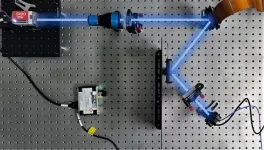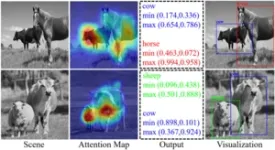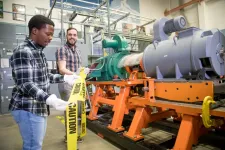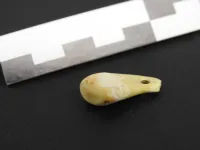(Press-News.org) WASHINGTON — Researchers have developed a new high-speed way to detect the location, size and category of multiple objects without acquiring images or requiring complex scene reconstruction. Because the new approach greatly decreases the computing power necessary for object detection, it could be useful for identifying hazards while driving.
“Our technique is based on a single-pixel detector, which enables efficient and robust multi-object detection directly from a small number of 2D measurements,” said research team leader Liheng Bian from the Beijing Institute of Technology in China. “This type of image-free sensing technology is expected to solve the problems of heavy communication load, high computing overhead and low perception rate of existing visual perception systems.”
Today’s image-free perception methods can only achieve classification, single object recognition or tracking. To accomplish all three at once, the researchers developed a technique known as image-free single-pixel object detection (SPOD). In the Optica Publishing Group journal Optics Letters, they report that SPOD can achieve an object detection accuracy of just over 80%.
The SPOD technique builds on the research group’s previous accomplishments in developing imaging-free sensing technology as efficient scene perception technology. Their prior work includes image-free classification, segmentation and character recognition based on a single-pixel detector.
“For autonomous driving, SPOD could be used with lidar to help improve scene reconstruction speed and object detection accuracy,” said Bian. “We believe that it has a high enough detection rate and accuracy for autonomous driving while also reducing the transmission bandwidth and computing resource requirements needed for object detection.”
Detection without images
Automating advanced visual tasks — whether used to navigate a vehicle or track a moving plane — usually require detailed images of a scene to extract the features necessary to identify an object. However, this requires either complex imaging hardware or complicated reconstruction algorithms, which leads to high computational cost, long running time and heavy data transmission load. For this reason, the traditional image first, perceive later approaches may not be best for object detection.
Image-free sensing methods based on single-pixel detectors can cut down on the computational power needed for object detection. Instead of employing a pixelated detector such as a CMOS or CCD, single-pixel imaging illuminates the scene with a sequence of structured light patterns and then records the transmitted light intensity to acquire the spatial information of objects. This information is then used to computationally reconstruct the object or to calculate its properties.
For SPOD, the researchers used a small but optimized structured light pattern to quickly scan the entire scene and obtain 2D measurements. These measurements are fed into a deep learning model known as a transformer-based encoder to extract the high-dimensional meaningful features in the scene. These features are then fed into a multi-scale attention network-based decoder, which outputs the class, location and size information of all targets in the scene simultaneously.
“Compared to the full-size pattern used by other single-pixel detection methods, the small, optimized pattern produces better image-free sensing performance,” said group member Lintao Peng. “Also, the multi-scale attention network in the SPOD decoder reinforces the network’s attention to the target area in the scene. This allows more efficient extraction of scene features, enabling state-of-the art object detection performance.”
Proof-of-concept demonstration
To experimentally demonstrate SPOD, the researchers built a proof-of-concept setup. Images randomly selected from the Pascal Voc 2012 test dataset were printed on film and used as target scenes. When a sampling rate of 5% was used, the average time to complete spatial light modulation and image-free object detection per scene with SPOD was just 0.016 seconds. This is much faster than performing scene reconstruction first (0.05 seconds) and then object detection (0.018 seconds. SPOD showed an average detection accuracy of 82.2% for all the object classes included in the test dataset.
“Currently, SPOD cannot detect every possible object category because the existing object detection dataset used to train the model only contains 80 categories,” said Peng. “However, when faced with a specific task, the pre-trained model can be fine-tuned to achieve image-free multi-object detection of new target classes for applications such as pedestrian, vehicle or boat detection.”
Next, the researchers plan to extend the image-free perception technology to other kinds of detectors and computational acquisition systems to achieve reconstruction-free sensing technology.
Paper: L. Peng, S. Xie, T. Qin, L. Cao, L. Bian, “Image-free single-pixel object detection,” Opt. Lett., vol. 48, issue 10, pp. 2527-2530 (2023).
DOI: doi.org/10.1364/OL.486078.
About Optics Letters
Optics Letters offers rapid dissemination of new results in all areas of optical science with short, original, peer-reviewed communications. Optics Letters accepts papers that are noteworthy to a substantial part of the optics community. Published by Optica Publishing Group and led by Editor-in-Chief Miguel Alonso, Institut Fresnel, École Centrale de Marseille and Aix-Marseille Université, France, University of Rochester, USA. For more information, visit Optics Letters.
About Optica Publishing Group (formerly OSA)
Optica Publishing Group is a division of Optica (formerly OSA), Advancing Optics and Photonics Worldwide. It publishes the largest collection of peer-reviewed content in optics and photonics, including 18 prestigious journals, the society’s flagship member magazine, and papers from more than 835 conferences, including 6,500+ associated videos. With over 400,000 journal articles, conference papers and videos to search, discover and access, Optica Publishing Group represents the full range of research in the field from around the globe.
END
Researchers detect and classify multiple objects without images
High-speed method uses less computational power, could be useful for autonomous driving
2023-05-03
ELSE PRESS RELEASES FROM THIS DATE:
Study provides genetic evidence on new osteoporosis drug heart attack risk
2023-05-03
New research highlights potential safety concerns around women taking romosozumab, a new anti-osteoporosis drug available on the NHS. The University of Bristol-led study, published in Arthritis & Rheumatology, analysed genetic data on nearly 34,000 people.
Despite romosozumab being particularly effective at reducing the risk of fracture in women with severe osteoporosis, potential safety concerns following trial data suggest the drug may cause an increased risk of heart attack. However, subsequent research has produced conflicting results.
An international team, led by Bristol Medical School researchers, sought to investigate whether, ...
OSU research shows how hackers can target smart meters to destabilize electricity grid
2023-05-03
CORVALLIS, Ore. – A power transmission grid can be destabilized by hackers who manipulate smart meters to create an oscillation in electricity demand, researchers in the Oregon State University College of Engineering have shown.
Findings were published in IEEE Access.
The study is important because understanding where a grid’s vulnerabilities lie and what they look like is the first step in designing protection mechanisms, says associate professor of electrical engineering and computer science Eduardo Cotilla-Sanchez, who led the project with graduate student Falah Alanazi.
A ...
New catalyst transforms carbon dioxide into sustainable byproduct
2023-05-03
The need to capture CO2 and transport it for permanent storage or conversion into valued end uses is a national priority recently identified in the Bipartisan Infrastructure Law to move toward net-zero greenhouse gas emissions by 2050.
Now, Northwestern University researchers have worked with an international team of collaborators to create acetic acid out of carbon monoxide derived from captured carbon. The innovation, which uses a novel catalyst created in the lab of professor Ted Sargent, could spur new interest in carbon capture and storage.
“Carbon capture is feasible today from a technical point of view, but not yet from an economic point ...
Virtual consulting can significantly cut carbon footprint in health care, new study suggests
2023-05-03
Virtual consulting is a new and emerging contributor to environmentally sustainable health care, according to findings of new research published in the Journal of Medical Internet Research.
The COVID-19 pandemic has accelerated the shift to virtual consulting, leading to its growing use. As health systems across the world strive to achieve net-zero carbon emissions, a critical question arises: what is the impact of virtual consulting on environmental sustainability in health care? A new research study led by Sara Shaw and team aims to address this ...
USC Verdugo Hills Hospital nationally recognized with first ‘A’ hospital safety grade
2023-05-03
LOS ANGELES — For the first time, USC Verdugo Hills Hospital (USC-VHH) earned an “A” Hospital Safety Grade from The Leapfrog Group, an independent national watchdog organization, for achieving the highest national standards in patient safety. This achievement places USC-VHH among top tier hospitals in the nation for safety and quality.
“Our entire staff is dedicated to improving and upholding the highest standards of patient care,” said Mary Virgallito, MSN, RN, chief quality officer at USC-VHH. “This score reinforces our ...
In a first, astronomers spot a star swallowing a planet
2023-05-03
As a star runs out of fuel, it will billow out to a million times its original size, engulfing any matter — and planets — in its wake. Scientists have observed hints of stars just before, and shortly after, the act of consuming entire planets, but they have never caught one in the act until now.
In a study that will appear in Nature, scientists at MIT, Harvard University, Caltech, and elsewhere report that they have observed a star swallowing a planet, for the first time.
The ...
Traces from the past
2023-05-03
Artefacts made of stone, bones or teeth provide important insights into the subsistence strategies of early humans, their behavior and culture. However, until now it has been difficult to attribute these artefacts to specific individuals, since burials and grave goods were very rare in the Palaeolithic. This has limited the possibilities of drawing conclusions about, for example, division of labor or the social roles of individuals during this period.
In order to directly link cultural objects to specific individuals and thus gain deeper insights into Paleolithic ...
New tusk-analysis techniques reveal surging testosterone in male woolly mammoths
2023-05-03
Graphics // Video
Traces of sex hormones extracted from a woolly mammoth's tusk provide the first direct evidence that adult males experienced musth, a testosterone-driven episode of heightened aggression against rival males, according to a new University of Michigan-led study.
In male elephants, elevated testosterone during musth was previously recognized from blood and urine tests. Musth battles in extinct relatives of modern elephants have been inferred from skeletal injuries, broken tusk tips and other indirect lines of evidence.
But the new study, scheduled ...
Evaluation of Waning of SARS-CoV-2 Vaccine–Induced Immunity
2023-05-03
About The Study: The findings of this systematic review and meta-analysis of secondary data from 40 studies suggest that the effectiveness of COVID-19 vaccines against laboratory-confirmed Omicron or Delta infection and symptomatic disease rapidly wanes over time after the primary vaccination cycle and booster dose. These results can inform the design of appropriate targets and timing for future vaccination programs.
Authors: Piero Poletti, Ph.D., of the Bruno Kessler Foundation in Trento, Italy, is the corresponding author.
To access the embargoed study: Visit our For The Media website at this ...
Researchers capture elusive missing step in the final act of photosynthesis
2023-05-03
Menlo Park, Calif. – Photosynthesis plays a crucial role in shaping and sustaining life on Earth, yet many aspects of the process remain a mystery. One such mystery is how Photosystem II, a protein complex in plants, algae and cyanobacteria, harvests energy from sunlight and uses it to split water, producing the oxygen we breathe. Now researchers from the Department of Energy’s Lawrence Berkeley National Laboratory and SLAC National Accelerator Laboratory, together with collaborators from Uppsala University and Humboldt University and other institutions have succeeded in cracking a key secret of Photosystem II.
Using SLAC’s Linac Coherent Light ...
LAST 30 PRESS RELEASES:
James Webb telescope reveals spectacular atmospheric escape
ICE-CSIC leads a pioneering study on the feasibility of asteroid mining
Dramatic rise in young people using mental health services
Be careful trusting TikTok for gout advice
A study by the University of Seville links the vanishing of the specific heats at absolute zero with the principle of entropy increase
Anxiety and insomnia may lower natural killer cell count, potentially repressing immune function
How parasitic, asexual plants evolve and live
Research spotlight: A subset of patients with depression could benefit from anti-inflammatory treatment
New fully digital design paves the way for scalable probabilistic computing
Membrane electrode assembly design for high-efficiency anion exchange membrane water electrolysis
U.S. debt ceiling disputes show measurable impact on global crude oil markets
Climate extremes triggered rare coral disease and mass mortality on the Great Barrier Reef
Direct observation reveals “two-in-one” roles of plasma turbulence
Humans rank between meerkats and beavers in monogamy ‘league table’
US fossil reveals early mass-burial event and ancient microbial attack
Sedative choice could improve outcomes for breathing tube patients
New superconducting thin film for quantum computer chips
Simulations reveal protein "dynamin" constricts cell membranes by loosening its grip
Nearly 1 in 5 UK emergency department patients cared for in corridors/waiting rooms
Heavy energy drink intake may pose serious stroke risk, doctors warn
Violence against women and children among top health threats: New global study reveals disease burden far larger than previously estimated
Predicting who is at risk of developing type 1 diabetes, as new drugs now available
New gene-mapping method unlocks hidden drivers of cancer
Ocean current and seabed shape influence warm water circulation under ice shelves
Call to increase funding for ‘invisible’ Deaf victim-survivors of domestic abuse
University of Maryland School of Medicine names distinguished scientist and academic leader Gerald M. Wilson, PhD, as Chair of the Department of Biochemistry and Molecular Biology
Receptors in mammary glands make livestock and humans inviting hosts for avian flu
Icy hot plasmas
Treating adults with autism: Maryland Clinical Center offers national blueprint for care after pediatric transition
University of Phoenix College of Doctoral Studies releases white paper on reclaiming control to build workforce resilience
[Press-News.org] Researchers detect and classify multiple objects without imagesHigh-speed method uses less computational power, could be useful for autonomous driving





